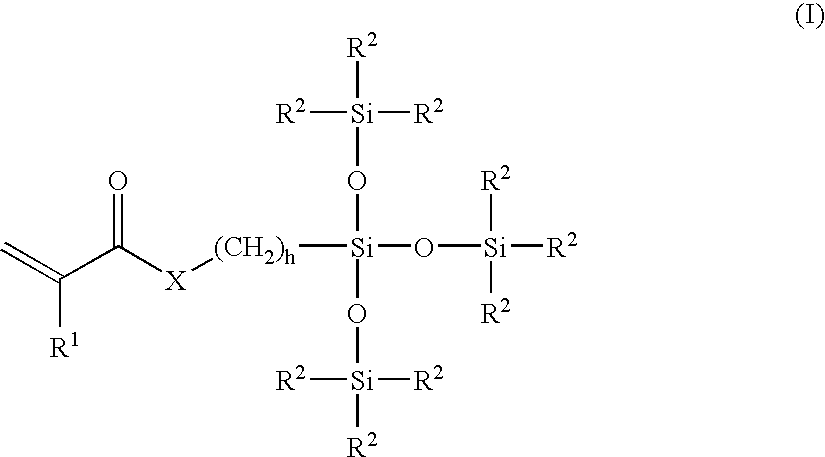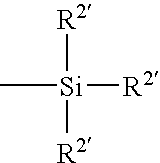Packaging Solutions
a technology for packaging solutions and lenses, applied in the field of packaging solutions, can solve the problem that the solution does not contain an effective disinfectant amount, and achieve the effect of preventing the contamination of the lens
- Summary
- Abstract
- Description
- Claims
- Application Information
AI Technical Summary
Benefits of technology
Problems solved by technology
Method used
Image
Examples
example 1
[0048]A master batch solution was prepared by mixing 50 mg of a copolymer of 2-methacryloyloxytheyl phosphorylcholine and n-butyl methacrylate (MPC-BMA) in 50 mL of phosphate buffered saline (PBS, pH=7.4), to obtain a PBS solution with a concentration of 0.1 wt % MPC-BMA. The MPC-BMA was supplied by NOF America under the tradename Purebright MB-37-50T.
[0049]Two types of contact lenses were tested. The first contact lenses were PureVision™ contact lenses (Bausch & Lomb Incorporated), made of balafilicon A copolymer, a Group III contact lens. The second contact lenses were Oasys™ contact lenses (Johnson & Johnson Vision Care), made of senofilcon A copolymer, a Group II contact lens.
[0050]Summarized in Table 1, Treatment A of the contact lenses involved soaking the contact lenses 30 minutes in water, as a control. Treatment B involved soaking the contact lenses 20 hours in the MPC-BMA test solution, followed by soaking 30 minutes in water. Treatment C involved soaking the contact lense...
example 2
[0052]Various tests were performed to assess the compatibility of the packaging solutions of this invention with the balafilcon A Group III contact lenses. The packaging solution included 0.1 wt % of the MPC-BMA copolymer of Example 1 in phosphate buffered saline (pH 7.2). The balafilcon A contact lenses were immersed in this packaging solution of Example 1 in glass vials. The packaged lens and solution were autoclaved for 30 minutes at 121° C.
[0053]Table 2 lists the contact lens dimensions after autoclaving, as well as target parameters. Table 3 lists the packaging solution properties before and after autoclaving. Both the contact lenses and packaging solution were sufficiently stable in these test regimens.
TABLE 2Lens ParameterAfter AutoclaveTargetDiameter14.08 ± 0.03mm14.00 ± 0.20mmSaggital Depth3.68 ± 0.02mm3.65 ± 0.10mmCenter Thickness0.10 ± 0.00mm0.09 ± 0.02mmPower−3.00 ± 0.00diopter−3.00 ± 0.125diopterCosmetic Appearance(= to control)—
TABLE 3Solution ParameterBefore Autoclave...
example 3
[0054]A first packaging solution was prepared by employing 0.01 wt % of the MPC-BMA copolymer of Example 1 in phosphate buffered saline (designated as Test Solution A below). A second packaging solution was prepared by employing 1 wt % of the M-PC-BMA copolymer of Example 1 in phosphate buffered saline (designated as B below). Commercial PureVision™ balafilcon A contact lenses (designated as Comparative Solution below), packaged in borate buffered saline, were used for comparative purposes. Balafilicon A contact lenses were soaked in the respective solutions for no fewer than 72 hours. Lenses were then removed from the test solution (and in the case of the comparative lenses, lenses were removed from the BBS packaging solution) and were immediately mounted and tested in 1 mL phosphate borate saline (PBS). Tribological testing was performed on a CETR Model UMT-2 micro-tribometer. Each lens was clamped on an HDPE holder that initially mates with the posterior side of the lens. A poly(...
PUM
| Property | Measurement | Unit |
|---|---|---|
| osmolality | aaaaa | aaaaa |
| weight percent | aaaaa | aaaaa |
| pH | aaaaa | aaaaa |
Abstract
Description
Claims
Application Information
 Login to View More
Login to View More - R&D
- Intellectual Property
- Life Sciences
- Materials
- Tech Scout
- Unparalleled Data Quality
- Higher Quality Content
- 60% Fewer Hallucinations
Browse by: Latest US Patents, China's latest patents, Technical Efficacy Thesaurus, Application Domain, Technology Topic, Popular Technical Reports.
© 2025 PatSnap. All rights reserved.Legal|Privacy policy|Modern Slavery Act Transparency Statement|Sitemap|About US| Contact US: help@patsnap.com



